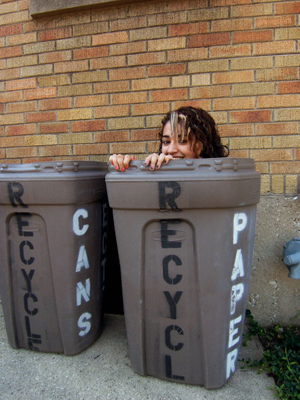All Nonfiction
- Bullying
- Books
- Academic
- Author Interviews
- Celebrity interviews
- College Articles
- College Essays
- Educator of the Year
- Heroes
- Interviews
- Memoir
- Personal Experience
- Sports
- Travel & Culture
All Opinions
- Bullying
- Current Events / Politics
- Discrimination
- Drugs / Alcohol / Smoking
- Entertainment / Celebrities
- Environment
- Love / Relationships
- Movies / Music / TV
- Pop Culture / Trends
- School / College
- Social Issues / Civics
- Spirituality / Religion
- Sports / Hobbies
All Hot Topics
- Bullying
- Community Service
- Environment
- Health
- Letters to the Editor
- Pride & Prejudice
- What Matters
- Back
Summer Guide
- Program Links
- Program Reviews
- Back
College Guide
- College Links
- College Reviews
- College Essays
- College Articles
- Back
To Save or not to Save the Environment?
A typical survey of my community’s eco-friendliness would include the following: hybrid cars, reusable water bottles, recycling bins and bike lanes. Certainly, my community’s progress, representative of our nation’s progress as a whole, has come a long way since the 1980’s and 1990’s. In recent years, saving our environment and taking steps to leave behind our current environmental crisis have been highlighted by our nation’s leaders, as well as non-political activists, such as Colin Beavan, author of No Impact Man. However, the same walk through my community would also yield littering, manufacturing-produced pollution and Hummers and other gas-guzzling cars. My community is not perfect, but it is striving to be. Shouldn’t we all be striving to do more to protect our environment? In theory, we should be. However, many teenagers don’t understand – and thus don’t participate in – the easy, more basic methods of eco-friendliness, practices such as recycling and driving more fuel efficiently. By not being able to start with basic practices, how can they move up later on in life to eat organic food, choose public transportation over cars and become an activist for the environment?
Our nation’s relative failure to educate students (and adults) about the state of our environment is contributing to our environmental decline that will only worsen the situation. According to the movie An Inconvenient Truth, a documentary on the environment, the average citizen in the United States produces 5.50 tons of carbon per year, 5.5 times the world average, almost 3 tons of carbon per person annually than Russia, the country directly below the U.S. By contrast to public opinion, countries like China and India only produce 0.53 and 0.25 tons of carbon per person per year, respectively. Our first-world lifestyle has caused us to be the heaviest producers of carbon per capita in the entire world, directly influencing the global environment the most. Our carbon-producing lifestyle has led the United States to directly contribute 30.3% to global warming. This value is higher than the entire continents of South America, Africa, Australia, Asia (including Russia) and Europe (excluding Russia). America’s prodigious carbon footprint and environmental damage demonstrate the need for stronger education about environmentally-sound practices and greater awareness of the world’s most pressing environmental concerns.
The days when it was acceptable to waltz around not caring about our relative impact on the environment and climate change and blaming developing nations for the environmental crisis are over. Regardless of the initial shock this may cause to the public, actions need to be taken in order to protect and preserve our environment as we know it. The first step is education of our youth. With education, we can enable my generation and future generations to self-evaluate our lifestyle and create change personally. In the words of Colin Beavan, author of No Impact Man, one person may not make a substantial difference, but the combined efforts of many will produce significant and lasting change. According to Beavan, at our current rate, the average American is producing 1600 pounds of trash per year. Our American lifestyle has harmed the environment but has also caused a rise in asthma-related diagnoses in the South Bronx because of exhaust fumes from dump trucks to a lower overall citizen happiness index: we placed 150th among 178 countries despite producing the greatest ecological footprint (happiness index is calculated: (life satisfaction * life expectancy)/(ecological footprint)). Clearly there is not much benefit in our current habits as a nation. When faced with this information from a variety of angles, it is now time to begin looking at our next steps in terms of eco-friendliness.
As global citizens, it is our duty to play a role in committing to a healthier planet and diminishing human impact on the environment. We must begin to take further steps to educate our youth and our future generations about our environmental crisis and what they can do to mitigate the problem. We must encourage our adults to set positive examples for their children by being role models and modeling environmentally-friendly habits, such as driving hybrid cars and recycling, in hopes that we will emulate those practices. We must encourage our leaders to set aside personal and political differences and really focus on what both parties and the government can do to help our new promise of moving forward environmentally. Let’s make a late New Year’s resolution. (A very late one at that…) Let’s resolve to step into a new era of environmental friendliness and reducing our carbon footprints.

Similar Articles
JOIN THE DISCUSSION
This article has 0 comments.
